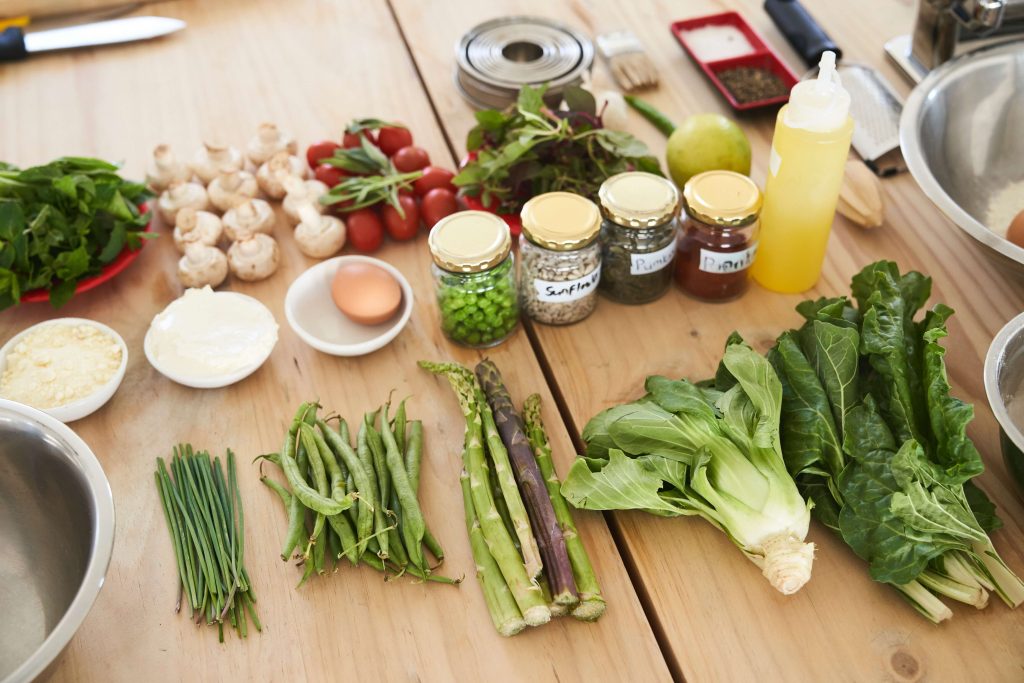As an avid fan of asparagus, I am often asked if it’s safe to eat it raw. The short answer is yes, you can eat asparagus raw. However, there are some things you should keep in mind before chomping down on a raw asparagus spear.
First off, while raw asparagus is safe to eat, it can be tough to chew and digest. This is because asparagus contains cellulose, a tough, fibrous material that gives plants their structure. Cooking asparagus breaks down the cellulose and makes it easier to digest, which is why many people prefer their asparagus cooked.
Benefits of Asparagus
Asparagus is not only a delicious vegetable, but it is also packed with nutrients and health benefits. Here are some of the benefits of incorporating asparagus into your diet:
- High in nutrients: Asparagus is a great source of many vitamins and minerals, including vitamins A, C, E, and K, folate, potassium, and fiber.
- Good for digestion: The fiber in asparagus helps to promote healthy digestion, reducing the risk of constipation and other digestive issues.
- May help with weight loss: Asparagus is low in calories but high in fiber, making it a great addition to any weight loss diet. It also contains compounds that can help to regulate blood sugar levels, reducing cravings and helping to maintain a healthy weight.
- May have cancer-fighting properties: Asparagus contains a compound called asparagine, which has been shown to have anti-cancer effects in animal studies. It may also help to prevent the growth and spread of certain types of cancer cells.
- Good for your skin: The high levels of vitamin C and E in asparagus can help to boost collagen production, promoting healthy skin and reducing the signs of aging.
Overall, asparagus is a great vegetable to incorporate into your diet for its many health benefits. However, it should be noted that consuming asparagus raw may not be as beneficial as cooking it, as cooking can help to release more of its nutrients.
So while it is possible to eat asparagus raw, it is recommended to cook it to fully reap its health benefits.
How to Prepare Raw Asparagus
Preparing raw asparagus might seem daunting, but with the right techniques, it’s actually quite simple.
Step 1: Choose the Right Asparagus
Choosing fresh and organic asparagus is crucial for preparing it raw. Ensure that the asparagus you choose is firm and crisp, with tightly closed tips and smooth stems.
Step 2: Wash and Dry the Asparagus Properly
Washing raw asparagus is vital to remove any dirt or debris that may be present. Rinse the asparagus under cold water and then pat dry with a clean cloth or paper towel.
Step 3: Cut or Break it Properly
To prepare asparagus for raw consumption, you need to cut or break off the tough woody ends.
- The best way to do this is to bend the asparagus near the end until it snaps off naturally. This typically happens about one to two inches from the bottom.
- If cutting, use a sharp knife to cut off around one to two inches from the bottom to remove the woody ends.
Step 4: Slice the Asparagus into Bite-Sized Pieces
Once the woody ends are removed, slice the asparagus into bite-sized pieces. You can use a vegetable peeler, mandoline, or sharp knife to slice the asparagus lengthwise into thin ribbons or cut crosswise into small rounds.
Step 5: Store Properly
Raw asparagus can be stored in the refrigerator wrapped in a damp towel for up to three days.
Preparing raw asparagus is an excellent way to enjoy its natural flavor and retain its nutritional value. With these simple steps, you can prepare raw asparagus with ease and add it to your salads, sushi, or other raw dishes.

Raw Asparagus Recipes
Looking for some tasty and healthy raw asparagus recipes? Look no further! Here are a few easy recipes to incorporate raw asparagus into your diet:
Raw Asparagus Salad
Ingredients:
- 1 bunch of asparagus
- 1/4 cup of olive oil
- 1/4 cup of freshly squeezed lemon juice
- 1/4 teaspoon of sea salt
- 1/4 teaspoon of black pepper
- Parmesan cheese, shaved (optional)
Instructions:
- Cut off the tough ends of the asparagus and shave the asparagus into long, thin strips using a vegetable peeler.
- Place the asparagus in a mixing bowl with the olive oil, lemon juice, sea salt, and black pepper.
- Toss well until the asparagus is coated.
- Sprinkle with shaved Parmesan cheese, if desired.
Raw Asparagus Soup
Ingredients:
- 1 bunch of asparagus
- 1 cup of vegetable broth
- 1/4 cup of plain Greek yogurt
- 1 garlic clove, minced
- 1/4 teaspoon of sea salt
- 1/4 teaspoon of black pepper
- Chopped chives (optional)
Instructions:
- Cut off the tough ends of the asparagus and place the asparagus into a blender.
- Add the vegetable broth, Greek yogurt, garlic, sea salt, and black pepper to the blender.
- Purée the mixture until it is smooth.
- Pour the soup into a bowl and garnish with chopped chives, if desired.
Raw Asparagus Pesto
Ingredients:
- 1 bunch of asparagus
- 1/4 cup of olive oil
- 1/2 cup of fresh basil leaves
- 1/4 cup of pine nuts
- 1 garlic clove, minced
- 1/4 cup of Parmesan cheese, grated
- Sea salt and black pepper, to taste
Instructions:
- Cut off the tough ends of the asparagus and blanch the asparagus in boiling water for 1-2 minutes until bright green and tender.
- Drain the asparagus and pat it dry with a paper towel.
- Place the asparagus, olive oil, basil leaves, pine nuts, garlic, Parmesan cheese, sea salt, and black pepper into a food processor or blender.
- Pulse until the mixture is smooth and creamy.
- Serve the pesto as a dip or spread on crackers or toasted bread.
Raw asparagus can be a tasty and nutritious addition to your diet. Give these raw asparagus recipes a try and enjoy all the health benefits this vegetable has to offer!
Asparagus Nutrition Facts
Asparagus is a highly nutritious vegetable that is a good source of essential vitamins, minerals, and antioxidants. One cup of asparagus contains approximately:
- 27 calories
- 2.9 grams of protein
- 5.2 grams of carbohydrates
- 2.8 grams of fiber
- 0.2 grams of fat
Asparagus is also a good source of vitamins and minerals, including:
- Vitamin K: essential for blood clotting and bone health.
- Vitamin C: an antioxidant that helps protect cells from damage.
- Folate: important for proper cell growth and development.
- Potassium: essential for maintaining healthy blood pressure and heart function.
- Phosphorus: important for bone health and energy production.
In addition to these vitamins and minerals, asparagus contains a number of plant compounds that have been shown to have health benefits. For example, asparagus contains rutin, a flavonoid that has been shown to have anti-inflammatory properties. Asparagus also contains saponins, compounds that may help reduce the risk of certain cancers.

One of the most interesting properties of asparagus is that it contains a unique compound called asparagusic acid. When the body digests asparagusic acid, it produces a sulfurous compound that some people can detect in their urine. However, not everyone is able to detect this odor, and those who do may have a different level of sensitivity to it.
Overall, asparagus is a highly nutritious vegetable that can be enjoyed in a variety of ways. Whether you prefer it raw, roasted, grilled, or steamed, asparagus is a versatile and delicious way to add more nutrients to your diet.
Potential Risks of Eating Raw Asparagus
While raw asparagus may make for a crunchy addition to your salad or a healthy snack, there are some potential risks associated with eating it raw.
Firstly, raw asparagus can be harder to digest than cooked asparagus. This is because cooking softens the fibers in the vegetable, making them easier to break down. Eating raw asparagus can cause digestive discomfort such as bloating, gas, and abdominal pain.
Furthermore, raw asparagus contains naturally occurring compounds called “saponins”. While saponins have been shown to have some health benefits, such as reducing inflammation and boosting the immune system, they can also be toxic in high doses. Consuming large amounts of saponins can cause symptoms such as nausea, vomiting, and diarrhea.
It’s also worth noting that raw asparagus may harbor harmful bacteria such as E. coli or salmonella. These bacteria can cause food poisoning and other health issues. While cooking can help kill these bacteria, consuming raw asparagus increases the risk of infection.
Overall, while it’s not impossible to eat asparagus raw, there are potential risks associated with doing so. If you choose to eat raw asparagus, be sure to wash it thoroughly and consume it in moderation to avoid any negative consequences. However, if you have any digestive issues or concerns, it’s best to stick to cooked asparagus or consult with a medical professional.
How to Choose Fresh Asparagus
Choosing the right asparagus is essential to ensure you get the maximum flavor and nutrition from your dish. Here are some tips to help you choose fresh asparagus:
- Check the tips: Look for bright green or violet-tinged asparagus with tight tips that have gone to seed, which can appear as a slightly open tip with a feathery appearance. If the tip is limp or wilted, it is not fresh.
- Check the stems: The stem of the asparagus should be firm and straight, not woody or bendable. Bendy stems are a sign of old asparagus.
- Look for fresh cut ends: Fresh asparagus will have a bright white cut end, while older asparagus may have a yellowed or dried out cut end.
- Consider the thickness: Thick asparagus stems tend to be tougher and require longer cooking times, while thin asparagus cooks faster and is more tender. Choose the thickness that best suits your recipe.
- Sniff it: Fresh asparagus should have a slightly grassy and earthy scent. A strong, unpleasant odor can indicate old or spoiled asparagus.
When buying asparagus, consider purchasing from local farmers or farmers markets for the freshest and best quality product. Additionally, plan to consume your asparagus within a few days of purchase for optimal taste and quality.
Overall, with these simple tips, you can easily choose the freshest and best quality asparagus for your recipes.
Different Ways to Cook Asparagus
Asparagus is a versatile vegetable that can be cooked in multiple ways to provide an array of flavors and textures. Here are some popular ways to cook asparagus:
- Boiling: Boiling asparagus is a simple and quick method. First, bring a pot of salted water to a boil, then add the asparagus and cook for 3-5 minutes until tender. Once cooked, drain the water and serve.
- Steaming: Steaming is a healthy way to cook asparagus that also helps to preserve its nutrients. To steam asparagus, add about an inch of water to a pot and bring it to a boil. Place the asparagus in a steamer basket, cover the pot, and steam for 3-5 minutes.
- Grilling: Grilled asparagus has a smoky and slightly charred flavor that many people enjoy. To grill asparagus, brush it with olive oil and season with salt and pepper. Place it on the grill over medium-high heat, turning it occasionally for 5-7 minutes or until tender.
- Roasting: Roasting asparagus is another easy and tasty option. Preheat the oven to 400°F (200°C), coat the asparagus with olive oil and seasonings, then roast for 10-15 minutes until tender and slightly browned.
- Sautéing: Sautéed asparagus is a delicious and quick side dish that goes well with many meals. Heat a little olive oil or butter in a pan over medium-high heat, add the asparagus, and cook for 5-7 minutes until tender.
Each cooking method brings out a different flavor in asparagus, so it’s worth trying them all to see which one you prefer.
Storing Asparagus
When it comes to storing asparagus, there are a few tips you want to keep in mind to ensure it stays fresh and delicious for as long as possible. Here are some guidelines:
- Refrigerate promptly: Asparagus is perishable, so it’s important to refrigerate it promptly. Ideally, you want to store asparagus in the refrigerator within a few hours of purchasing or harvesting it.
- Trim the ends: Before storing asparagus in the fridge, trim the ends of the stalks by around 1-2 inches. This helps to remove any woody or tough parts that can make the asparagus less enjoyable to eat.
- Use a container: Place the trimmed asparagus in a container with around 1 inch of water at the bottom, then cover the container with a plastic bag. This helps to keep the asparagus hydrated and prevent it from drying out.
- Change the water frequently: If you’re storing asparagus for a few days, be sure to change the water in the container every day or two to keep it fresh.
- Store separately from other produce: Asparagus can release ethylene gas, which can cause other produce in your fridge to ripen and spoil more quickly. It’s a good idea to store asparagus in a separate compartment or drawer away from other produce.
- Don’t wash until ready to use: While it may be tempting to wash your asparagus immediately after buying it, it’s actually best to wait until you’re ready to use it. Moisture can cause asparagus to become slimy and spoil more quickly, so it’s best to keep it as dry as possible until you’re ready to cook it.
By following these guidelines, you can help to ensure that your asparagus stays fresh and delicious for several days. Just be sure to use it up before it starts to become slimy or develop an off-putting odor.
Frequently Asked Questions
Here are some common questions and answers surrounding the topic of eating raw asparagus:
Can you eat asparagus raw?
A: Yes, you can definitely eat asparagus raw! In fact, it can be an excellent addition to your salads, sandwiches, and even smoothies. Raw asparagus has a crunchy texture and a slightly sweet flavor that can add a fresh and vibrant taste to your dishes.
Is it safe to eat raw asparagus?
A: Yes, it is safe to eat raw asparagus. Just make sure to thoroughly wash it before consumption to remove any dirt, pesticides, or other contaminants. Also, keep in mind that eating too much asparagus – both raw and cooked – can cause stomach discomfort and a strong odor in urine.
How do you prepare raw asparagus?
A: To prepare raw asparagus, simply wash it thoroughly and trim off the tough ends of the spears. You can then slice it thinly or shave it into ribbons using a vegetable peeler. Raw asparagus can also be marinated or dressed with olive oil, lemon juice, and salt and pepper to add more depth of flavor.
Are there any nutritional benefits to eating raw asparagus?
A: Yes! Raw asparagus is rich in vitamins, minerals, and antioxidants that can benefit your health. For example, it’s a good source of vitamin K, which is essential for bone health, and folate, which is important for cell growth and development. It also contains asparagine, an amino acid that has been linked to better kidney function.
| Nutrient | Amount per 1 cup (134g) |
|---|---|
| Calories | 27 |
| Carbohydrates | 5.2 g |
| Protein | 2.9 g |
| Fat | 0.2 g |
| Fiber | 2.8 g |
| Vitamin C | 12.0 mg (20% DV) |
| Vitamin K | 58.2 mcg (73% DV) |
| Folate | 70.2 mcg (18% DV) |
| Asparagine | 311 mg (highest source) |

What are some recipe ideas for using raw asparagus?
Raw asparagus can be used in many different ways! Here are a few recipe ideas to try:
- Asparagus salad with shaved parmesan, lemon vinaigrette, and toasted almonds
- Asparagus and goat cheese sandwich with arugula and lemon aioli
- Asparagus and avocado smoothie with banana, ginger, and honey
- Asparagus and snap pea stir-fry with garlic, ginger, and soy sauce.
After all… Can You Eat Asparagus Raw?
Asparagus is a versatile vegetable that can be consumed in various ways. However, can you eat asparagus raw? The answer is yes.
Raw asparagus is safe to eat and provides a crispy texture with a slightly bitter taste. Additionally, consuming raw asparagus has more health benefits than cooked asparagus due to the preservation of nutrients during the heating process.
Although some people may prefer cooked asparagus for its milder taste and softer texture, raw asparagus is equally delicious when consumed fresh, in salads, or as a crunchy snack.
However, individuals with sensitive digestive systems or kidney problems may want to limit their raw asparagus intake due to the high levels of oxalic acid it contains, which can contribute to kidney stones.
As with most fruits and vegetables, it is always essential to wash asparagus thoroughly under running water to remove any dirt or pesticides before consuming it raw.
I have always loved cooking and discovering new flavors. My hobby gradually grew into a serious hobby and now I write about food professionally on my blog. For almost a year now, I’ve been sharing my thoughts with the world and helping many people find their perfect “recipe” 🙂

